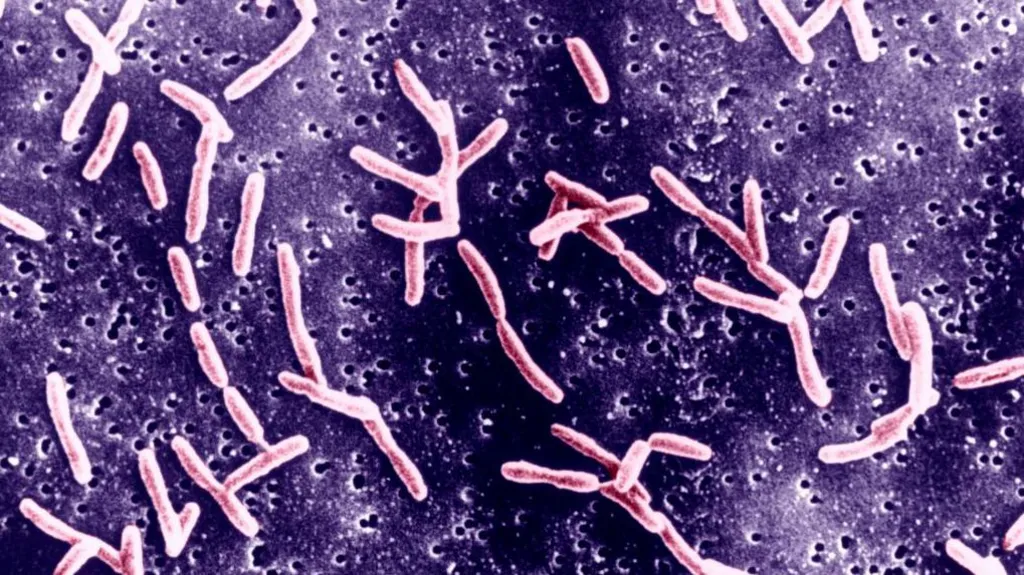BBC News, Mbarara
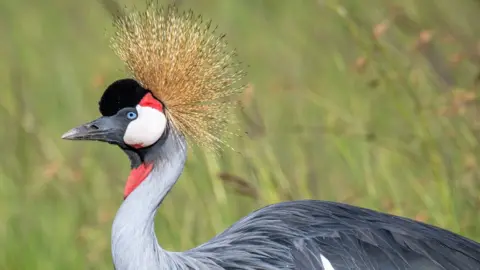 Getty Images
Getty ImagesWith its distinctive golden crown, red throat pouch and slender black legs, the crested crane is beloved in Uganda – featuring on the East African nation’s flag and coat of arms.
All the country’s national sports teams are also nicknamed after the iconic bird, but in recent years it has gone into decline and conservationists say it may face extinction if more is not done to protect it.
The bird is protected by law – it stipulates a life sentence and/or a fine of 20bn Ugandan shillings ($5m; £4m) for those found to have killed one.
Going back centuries, local Buganda cultural superstition also protected the elegant fowl, which was seen as a symbol of wealth, good fortune and longevity.
It was believed that if one killed a crane, its kith and kin would flock to the killer’s home, hold vigil and mourn by collectively honking until the person went mad or even died.
“Such stories instilled fear, and cranes would be respected and revered and not killed,” Jimmy Muheebwa, a senior conservationist at Nature Uganda, a local non-governmental organisation (NGO), told the BBC.
But for farmers in western Uganda, where the cranes mostly hang out, that fear has dissipated and often it is only conservationists who appear to know about the ban on killing them.
“I really don’t see any value in these birds because all they do is raid our plantations and eat our crops. We are worried about food security in this area,” Tom Mucunguzi, a maize farmer from a village near Mbarara city in Western Region, told the BBC.
Another farmer near Mbarara, Fausita Aritua, agreed, saying when she goes to her maize plot she spends the whole day chasing away the cranes – and if she cannot get there, she tries to get someone else to stand guard.
“We no longer harvest as much as we used to do because these birds eat everything,” she told the BBC.
Also known as grey-crowned cranes, the birds are predominantly found in Uganda but are also in Kenya, Tanzania, Rwanda, Burundi, Democratic Republic of Congo, Mozambique, South Africa and Zimbabwe.
They are non-migratory, but make local and seasonal movements depending on food resources, nest site availability and the weather.
Standing at about 1m (3.2ft) tall, the waterfowl mostly live in wetland areas – riverbanks, around dams and open grassland – where they breed and feed on grass seeds, small toads, frogs, insects and other invertebrates.
But with the increasing human population, the high demand for food is pushing farmers to cultivate in wetlands, leaving crested cranes with diminishing areas to call home.
“In eastern Africa, the population has declined terribly by over 80% in the last 25 years,” Adalbert Ainomucunguzi, who leads the International Crane Foundation (ICF) in East Africa, told BBC.
In the1970s, Uganda boasted a population of more than 100,000 crested cranes, but today that number has dwindled to a mere 10,000, according to Nature Uganda.
This decline saw the International Union for the Conservation of Nature (IUCN) put the crested crane on its red list of endangered bird species in 2012.
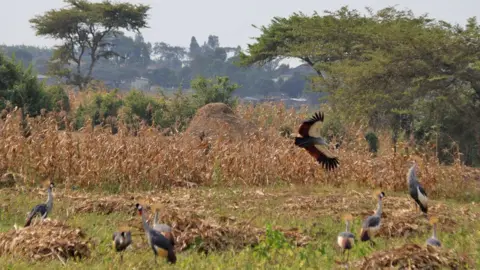
“Despite its serenity, beauty and popularity, the bird is facing a serious threat. It means that if no urgent measures are taken to reverse this trend, we might see the cranes pushed to extinction,” Dan Sseruge, a Ugandan ornithologist, told the BBC.
Around Mbarara we found it was difficult to track down the birds – and only saw them early in the morning just after dawn.
Conservationists say they used to be much easier to find in the landscape surrounding Mbarara.
Dozens of cranes have in recent years been found dead after they were poisoned by rice and maize farmers in Lwengo district, in south-central Uganda.
“One of the biggest threats against cranes is poisoning by the farmers. This is because the birds are causing a lot of crop damage,” Gilbert Tayebwa, a conservation officer at ICF, told BBC.
Mr Tayebwa said he has been engaging farmers to use different deterrent methods like scarecrows to protect their crops from invading cranes.
Farmers like Philip Ntare, from Lwengo, said the cranes were sometimes mistakenly poisoned after eating crops sprayed with agro-chemicals and other pesticides.
“I just chase them, because I grew up knowing the crested crane is not supposed to be killed. But government should consider compensating farmers for crop damage,” he told the BBC.
However, John Makombo, director of conservation at the Uganda Wildlife Authority (UWA), said this was not possible.
“It is one of those precious species that have freedom to go anywhere and so unfortunately the government is not liable for any damage done by the cranes,” he told the BBC.
Sarah Kugonza, an ICF conservationist, said the cranes also face a host of other threats – not just from farmers. Without the protective cover of the wetlands, their chicks are more likely to be captured by eagles.
Cranes are finding day by day that they are living in an increasingly hostile environment.
“Sometimes breeding areas are flooded and nowadays some cranes are killed by electricity lines when flying,” Ms Kugonza told BBC.
Their exceptional beauty has also put them at risk as people are increasingly capturing them to be pets, according to Mr Ainomucunguzi.
But crested cranes, who can live for just over two decades, hardly ever breed in captivity as the birds are famously faithful.
“It is a highly monogamous bird as it pairs once, for life. This means that if one of them is killed or domesticated, the likelihood of finding a new mating partner is almost zero,” said Mr Muheebwa.
They attract a mate by dancing, bowing and jumping – and are often seen walking as couples or families. A pair will define their own territory and can be very aggressive to defend it.
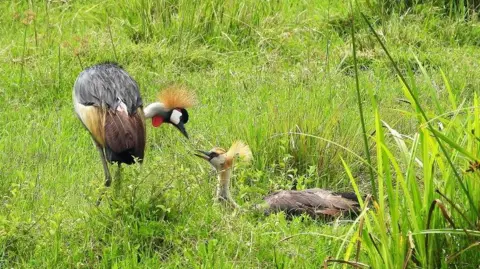 International Crane Foundation
International Crane FoundationScientifically called Balearica regulorum gibbericeps, the cranes also have unique nesting patterns as they usually return to the same location annually, often laying between two and five eggs that are incubated by both sexes for anywhere between 28 and 31 days.
Any destruction to these nesting areas impacts on these breeding patterns.
Their monogamy has also attracted the unwelcome attention of local traditional healers, who claim that the parts of crested crane may bring faithfulness from a partner – or good luck.
“Some people have been caught hunting cranes to take some of their body parts to witch doctors in a belief that they will get rich. Or, if you are a woman, your husband will never leave you,” Mr Tayebwa from ICF said.
This is also something conservationists are trying to counter – as well as alerting people to the law protecting cranes.
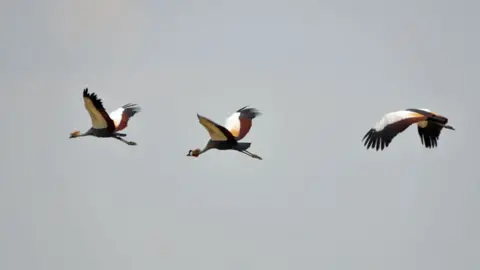
And in an effort to reverse declining numbers, the Ugandan government and conservationist groups are now rallying communities to restore wetlands.
President Yoweri Museveni, who comes from the Western Region, has been urging encroachers to vacate wetland areas and, according to local media, has declared 2025 a year of wetland conservation.
The ICF has also recruited custodians to monitor and ensure that the cranes’ breeding grounds are protected.
Nature Uganda’s Mr Muheebwa said these efforts were slowly helping to stabilise the situation but crane numbers remained “very low”.
For Mr Makombo, the UWA’s future emphasis is going to be on setting an example when it comes to the law.
“We shall arrest and prosecute those who are poisoning the cranes,” he said.
You may also be interested in:
 Getty Images/BBC
Getty Images/BBC

